CO2 laser resurfacing & biostimulator injectables
Biostimulation provides skin tightening, in turn reducing fine lines, wrinkles & skin laxity. The CO2 laser provides the highest levels of biostimulation of any energy device, however it is associated with a long recovery time. New injectables can add to the biostimulator effects of CO2 lasers to reduce downtime & compound the results of lasers. Choosing the correct pathway for your skin depends on your skin’s age, your ethnicity, expectations & downtime. Read more to understand how my team & I employ the latest technology & methods to achieve clinically reproducible results with extraordinary before & afters.
CO2 lasers & biostimulating injectables summarised
- CO2 lasers provide high levels of collagen production, also known as biostimulation
- Lasers erase signs of aging including deep wrinkles, sun damage & skin laxity
- The downside with CO2 laser resurfacing is the prolonged healing time
- Biostimulatory injectables augment the effects of CO2 lasers
- Injectables accelerate skin recovery & amplifies collagen production from lasers
- The injectable program takes into account your skin’s age, volume, thickness & degree of dermal hydration
What is biostimulation?
This is THE buzzword of skin rejuvenation in 2024 & beyond. It refers to a process of stimulating your immune system to produce collagen. Clinically effective biostimulation can be achieved with –
- Energy devices such as lasers, HIFU & radiofrequency, deep chemical peels
- Injectables that stimulate collagen production, as opposed to dermal fillers
Extremely low levels of biostimulation can be achieved (in some cases) with treatments such as lunchtime chemical peels, LEDs, & low power RF devices.
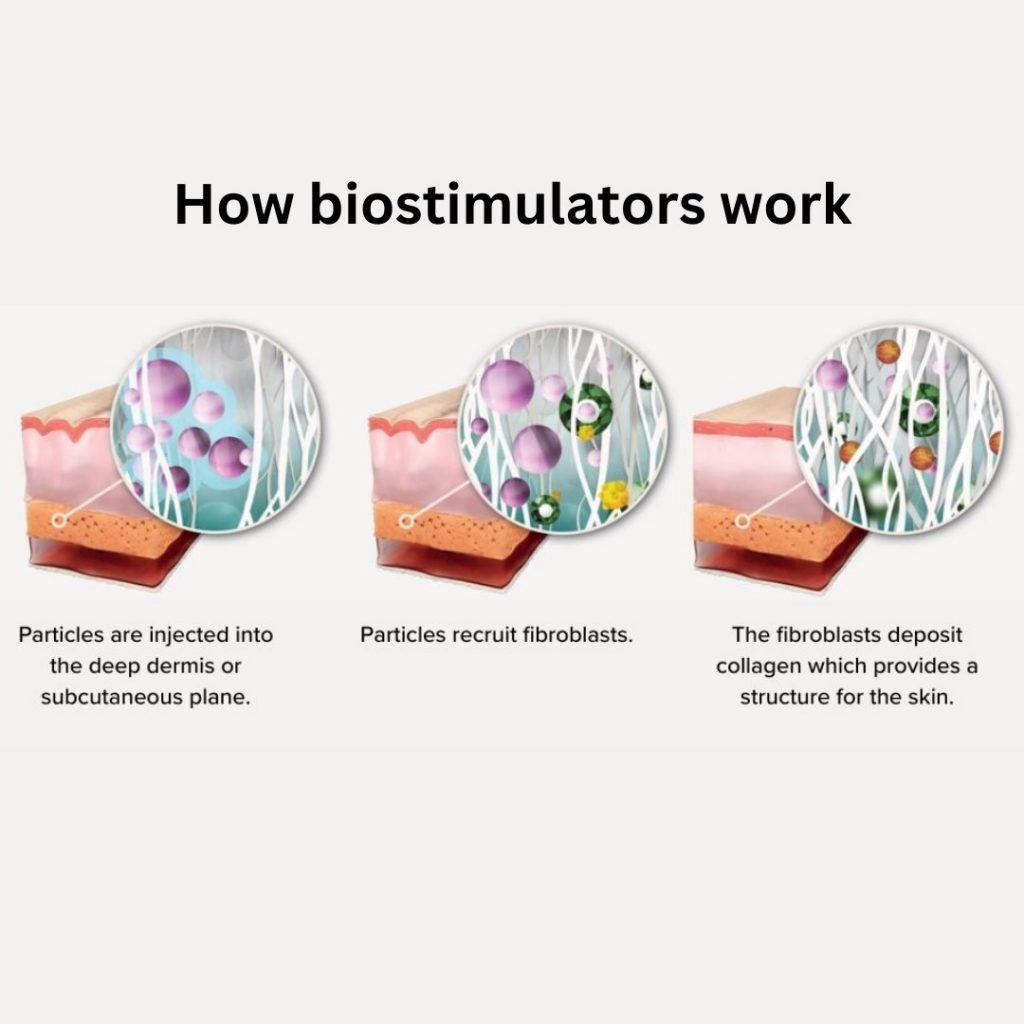
Why is it important to stimulate collagen production?

Collagen declines at a rate of 1.5% annually from age 20. It accelerates to 30% loss within 5 years of menopause. A 50 year old will have 40-60% less collagen in the skin as compared to the peak age.

What are examples of high & low level biostimulation (collagen production)?
High levels of collagen stimulation can be achieved with ablative lasers like CO2 laser resurfacing, or deep chemical peels.
Low levels of biostimulation can be achieved with collagen stimulating injectables.

What results can CO2 laser resurfacing achieve?
Fully ablative CO2 lasers can turn back time by as much as twenty years. This procedure essentially gives your skin a second shot of life, erasing decades of sun damage, wrinkles & skin laxity. It improves-
- Deep lines around the mouth, including smoker’s lines
- Eye wrinkles (upper & lower lids) in addition to crow’s feet
- Cheeks wrinkles & skin laxity
- Spots & pigmentation
- Scarring
- Sun damage & cancerous cells
- Improves dull skin


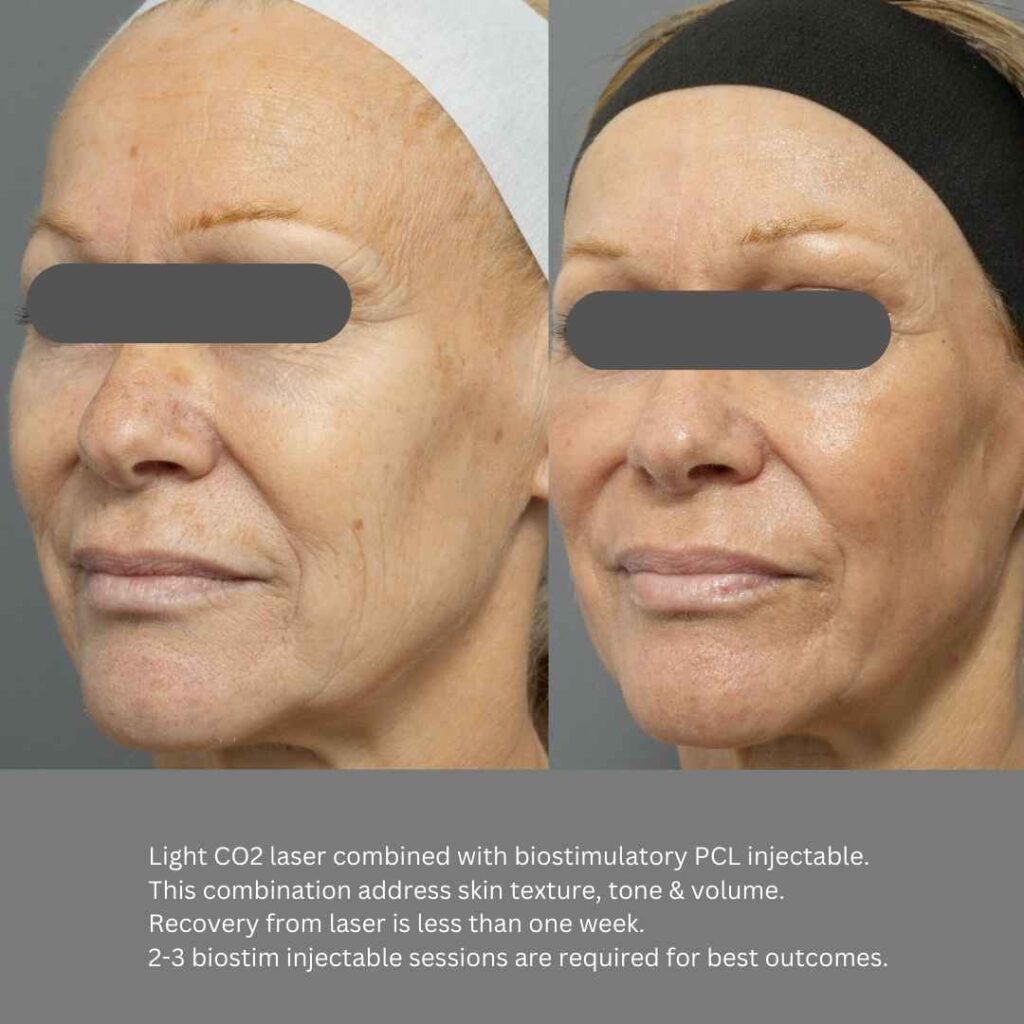
Is the procedure painful?
Yes, but we alleviate the discomfort with –
- Nerve blocks, numbing cream
- Sedation
- Cool air
Post CO2 laser resurfacing there is no pain. The procedure is performed in our accredited laser suites in Brisbane. Laser resurfacing in Sydney will be performed in a private hospital in the Eastern suburbs.
What is the recovery period?
CO2 laser resurfacing is an epic treatment with a significant downtime & recovery process that goes like this-
- Day 1-3: Weeping skin, marked swelling & oozing.
- Day 3-6: Skin starts to heal, reducing swelling & oozing.
Day 6-8: Skin 80% healed but very red with focal areas of crusting & scabs. - Week 2-4: Skin 100% healed with marked redness. Make up can be worn.
- Week 4-8: Redness subsides. Skin feels tight.
- Week 8 & beyond: Best results are seen when collagen is maximal at the 4 to 6 month mark.
This procedure is akin to a deep plane face lift, namely- one session, epic procedure, for LIFE.
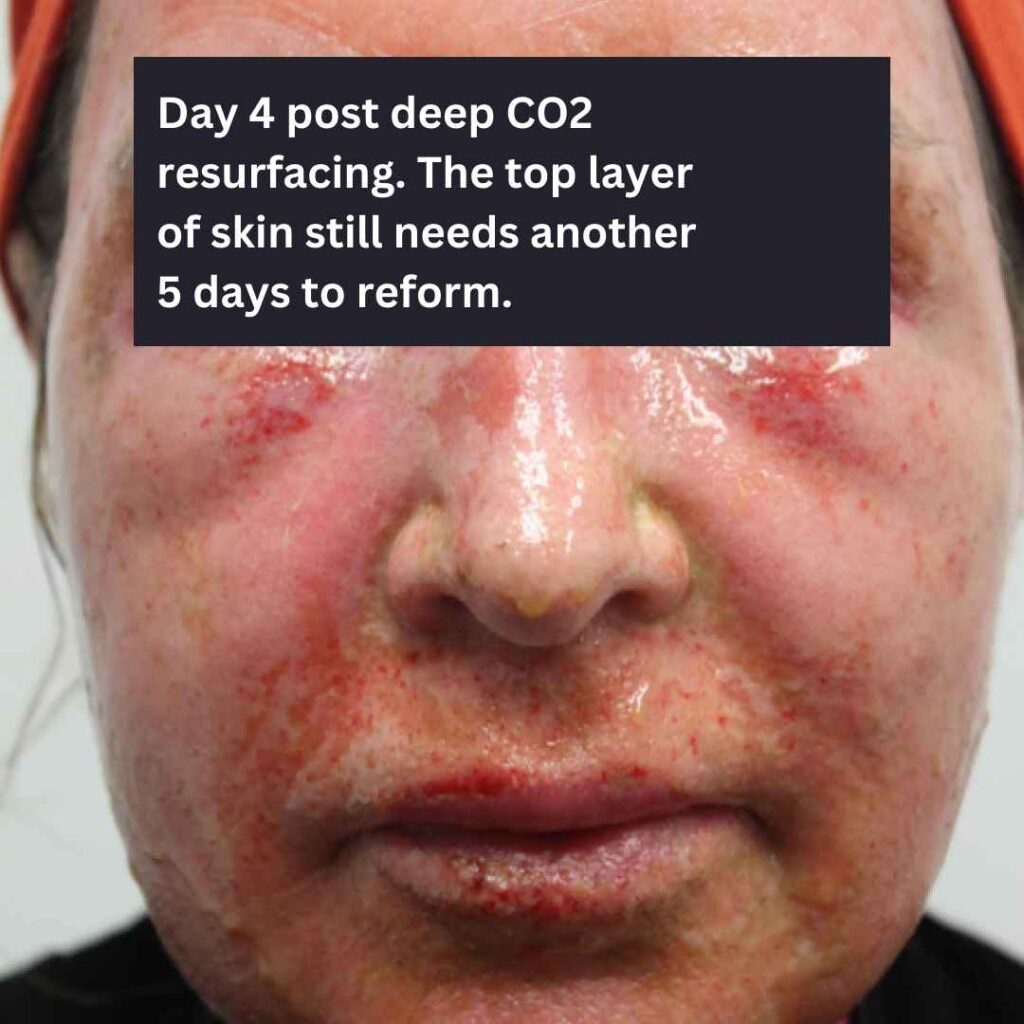


What types of CO2 lasers do I use?
I use several CO2 lasers including-
- The Ultrapulse for fully ablative work (big daddy powerful laser). This laser gives the most dramatic results & is the gold standard for collagen remodeling.
- Fractional lasers by Lutronic eCO2, Mixto, Hybrid CO2 by Alma, & CO2RE by Candela. Fractional lasers are much gentler on the skin & provide quicker recovery. The flipside is that the results are not as good as the Ultrapulse fully ablative laser.
How long will the results from resurfacing last?
Typically 5 to 20 years, the marked variation depends on factors such as-
- Your age
- Your previous sun exposure
- Future sun exposure
- Lifestyle factors (smoking, stress, diet, supplements)
- Future biostimulatory injectables to slow down collagen breakdown (more on this later)

Why do I incorporate biostimulators after laser resurfacing?
Biostimulators compound the effects of lasers by providing another source of stimuli for fibroblasts without the downtime & recovery of further energy devices. These injectables are spaced 4 to 8 weeks post laser as they-
- Aid in recovery of laser resurfacing by reducing redness & improving skin quality
- Potentiate the skin rejuvenating process that was initiated by laser resurfacing
- Provides superior clinical results when it comes to improvements in skin laxity, wrinkles, volume & laxity.
The ideal biostimulator depends on factors such as skin laxity, volume depletion, & end goals.
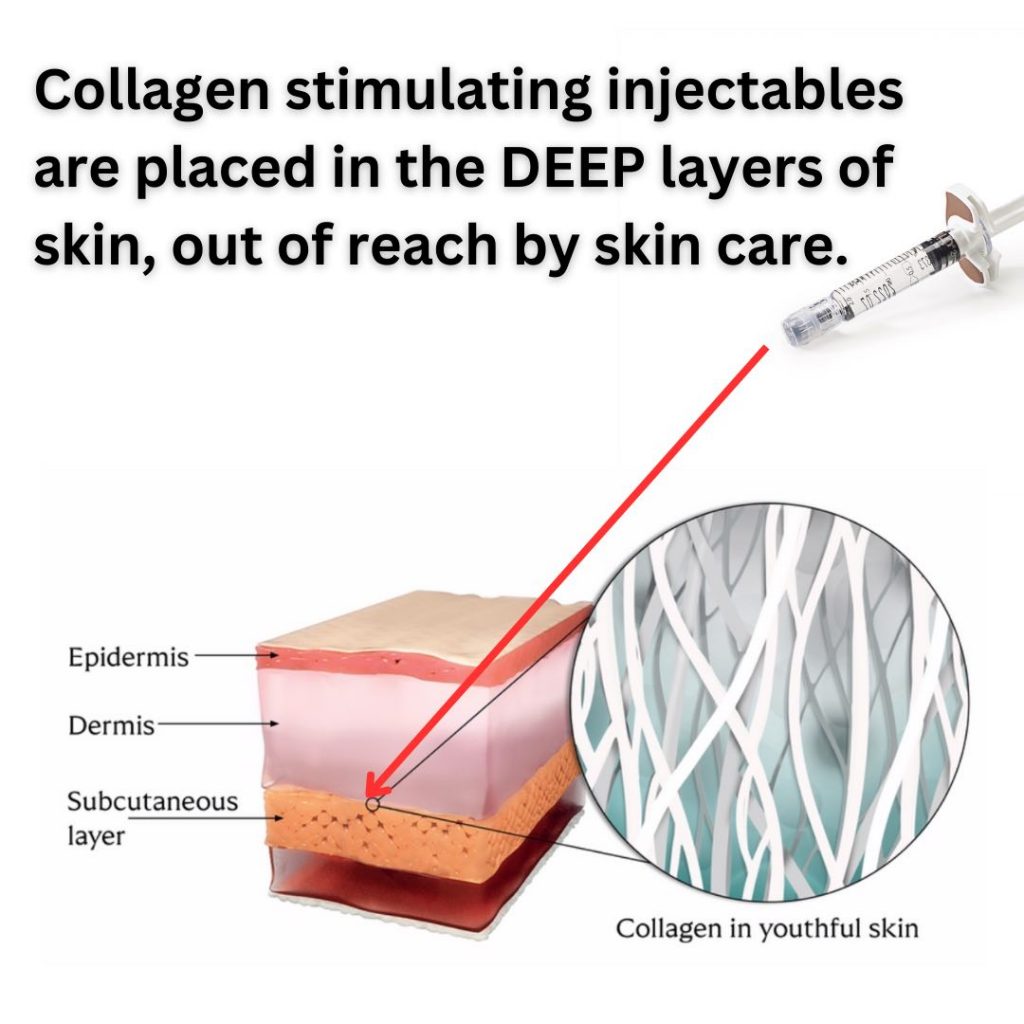
What types of biostimulator injectable are there?
The two groups of biostimulators that we have in Australia are-
- HA based
- Non-HA based
HA based biostimulators include Biostimulators (low & high molecular weight HA). This is great for hydration over skin tightening & volume. 2 sessions are performed 4 to 10 weeks apart. The injections are timed 6 to 8 weeks post laser.
Non-HA based biostimulators are better for skin tightening & volume. They include Polymer Injectable, CAH (Radiesse) as well as newer biostims such as PCL & polynucleotides. PCL is the best skin tightening biostimulator, whilst Polymer Injectable provides the balance between volume & skin tightening. Polynucleotides such as Rejuran provide the ‘icing’ on the skin rejuvenation pathway by improving skin quality & glow.

What biostimulator is best for volume & skin tightening?
The two main groups are Polymer Injectable & CAH, namely Polymer & Radiesse. I prefer Polymer over Radiesse in the more mature age group. As a guide, Polymer-
- Requires 2-4 sessions
- Has no downtime
- Takes 3-6 months for optimal results
- Last 2-4 years
- Is ideal for subtle & natural volume replacement
More on Polymer Injectable & Polymer
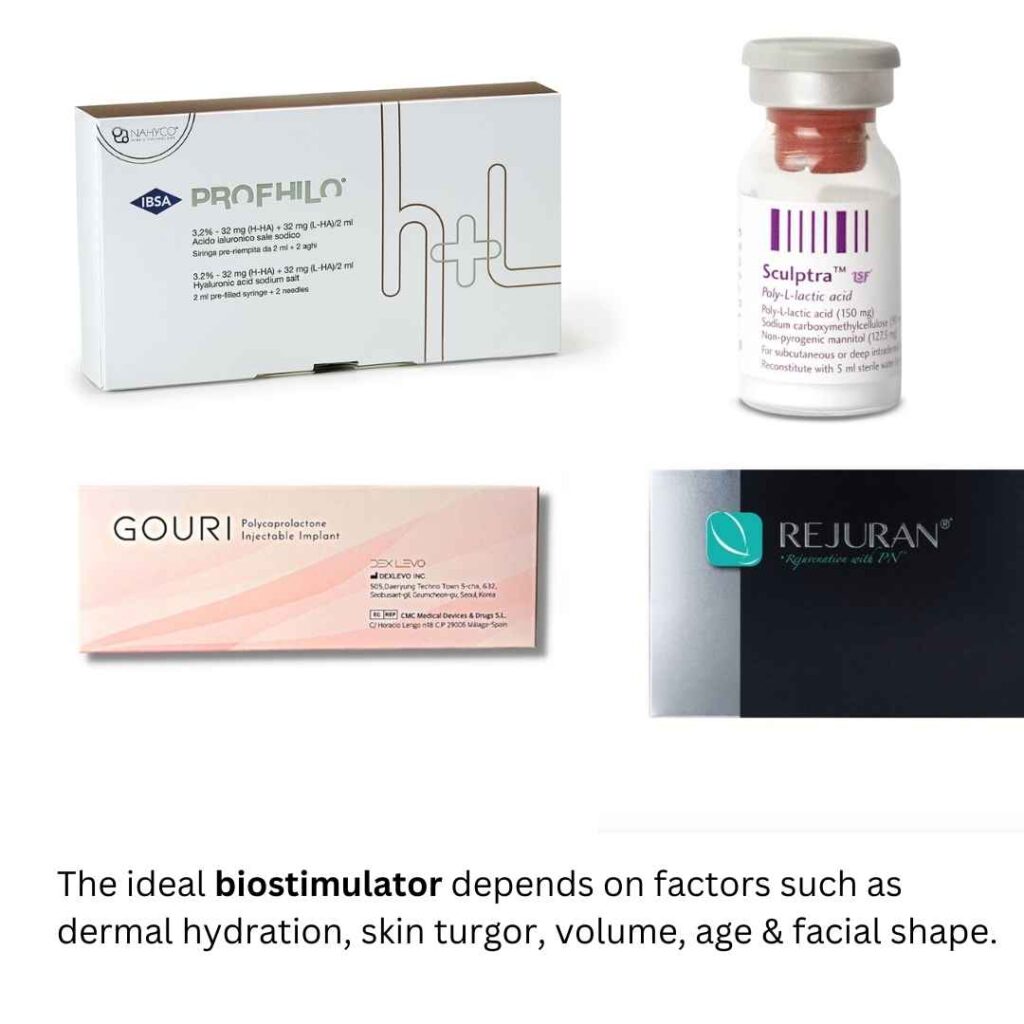
What does a typical biostimulatory regime look like?
First year: 2 sessions of HA based biostimulator, 2 sessions of non-HA based injectable.
Thereafter: 1 session of each
*The ideal type of biostimulator depends on your skin’s turgor, hydration, volume, degree of laxity, ethnicity & expectations.

Will I require injections for life?
To date the most reliable way to reduce collagen loss over time is with low level biostimulation using injectables. As with aging, it is inevitable that collagen loss will occur- even after big procedures like CO2 laser resurfacing. So, the answer is yes.
A simple biostimulatory injectable routine of visits every 6 to 12 months can slow down the process of aging, meaning longer lasting results from any resurfacing procedure.
What are other methods to provide biostimulation if I don’t want injectables?
Injectables are the most efficient way of providing biostimulation, however there are other devices that can provide marginal increases of collagen. They include-
- Radiofrequency: devices like Tempsure, NuEra, Venus Viva
- Ultrasound: HIFU & Ultraformer
- Clinical peels: High strength glycolic acid peels
- EMS/DMS muscle stimulation with RF
Ideally, low level biostimulatory devices are best combined with injectables, however in some cases they can provide clinically satisfactory results.
How does CO2 laser compare to Morpheus8 RF microneedling?
No comparison. RF microneedling with devices such as Morpheus8, Genius RFM, Secret RF, Infini & Potenza are designed to provide mild to moderate amounts of collagen production over a series of 3-4 sessions. Lasers are better for improving skin quality, skin tightening & wrinkles around the mouth & eyes. RF microneedling is reserved for cases of mild laxity & reduced skin tone.
What is the difference between Fraxel & CO2 laser resurfacing?
Fraxel has a CO2 laser. It’s really not very good. The flipside is that Fraxel has an awesome laser called the Fraxel Dual. This has 2 non-ablative wavelengths that deliver fractional laser beams. In summary, Fraxel is used for-
- Pigment & mild sun damage
- Mild wrinkles
- Enlarged pores
- Fraxel has a recovery of 3-5 days
- 3 sessions are required for optimal results

What are other alternatives if I am not quite ready for CO2 laser resurfacing?
A step down procedure from fully ablative CO2 is Hybrid laser resurfacing. This combines a high density Fraxel Dual with fractional ablative CO2 laser. Fractional means a percentage of skin treated. Fully ablative CO2 treats 100% of the skin’s surface, whilst fractional treats up to 30%. In summary the Hybrid laser treatment-
- Has a recovery time of 5 to 6 days
- Addresses wrinkles, sun damage, pigmentation & enlarged pores
- Can be done in one session
- Is a step down from fully ablative CO2 laser
- Provides medium to high levels of collagen
- Cost 1/4 the price of fully ablative CO2 laser resurfacing

Where do I perform CO2 laser resurfacing in Sydney?
I will be starting CO2 resurfacing in Sydney in early 2024, from a private hospital in the Eastern Suburbs. Though I will be consulting at our clinic in Woollahra, this clinic is set up as a boutique aesthetic center. It is not equipped for more involved procedures such as CO2 laser resurfacing.
What are the risks of CO2 laser resurfacing?
Risks include-
- Infection: cold sore virus & bacteria. Close followup prevents infections.
- Prolonged redness: maybe seen in 10% of patients. Easily treated with vascular lasers.
- Skin color changes: more common in darker skin patients. Hypopigmentation can be seen in cases of deep laser resurfacing.
- Iatrogenic scarring: is uncommon, & can be mitigated with close follow ups.
The risks of laser resurfacing can be markedly reduced with close follow up & early intervention.
What is the cost of fully ablative CO2 laser resurfacing?
What are the costs?
Fully ablative CO2 resurfacing: Deep- $10,900
Fully ablative CO2 resurfacing : Medium depth – $7990
Fully ablative CO2 resurfacing : Shallow- $5990
Collagen stimulating injectables range from $850 to $1290 per treatment.
Davin’s advice on CO2 laser resurfacing for skin rejuvenation

Don’t put all your eggs in one basket.
Lasers are awesome for reversing the signs of aging when it comes to textural changes, namely pigmentation, sun damage & wrinkles. WIth high intensity lasers like CO2 or erbium, they do provide some level of skin tightening. What devices do not do is to provide volume. Volume refers to the amount of deep fat (& to a lesser degreed, collagen). There are only two methods to replace volume; fat transfer & dermal fillers. For balanced rejuvenation, do not overlook volume replacement.
The concept of biostimulation
It’s necessary to keep your collagen healthy. This is the buzzword for the next decade of skin rejuvenation. It can be viewed as prejuvenation, or mitigation of collagen degradation. Biostimulatory injectables are designed to provide low levels of collagen regeneration that follows laser resurfacing. Lasers provide high levels of collagen biostimulation, whilst injectables propagate the process of remodeling. Here is a quick overview on injectables that I employ after CO2 laser resurfacing.
Biostimulators (high & low molecular weight heat stabilized hyaluronic acid injectable): as simple as it gets. This injectable is best for hydration of your skin aimed at the dermal layer. 2-3 sessions initially, followed by maintenance yearly. It can be used on the face, neck & decolletage. Not the best for volume, & provides minimal ‘skin tightening’, despite marketing claims.
Polymer Injectable & Polymer Collagen Stimulator (Polymer) is an oldie but a goodie. Polymer Collagen Stimulator provides more immediate volume correction. I use this in more mature patients with volume loss. 2-4 sessions in the first year, maintained 1-2 injections annually .
Polycaprolactone / PCL (Gouri & Ellanse). The best collagen stimulator/s with the best skin tightening. The former adds very little volume, whilst the latter adds more volume. 2-3 sessions to begin with (spaced 4-10 weeks apart), followed by annual top ups. PCL does not hydrate, unlike hyaluronic acid biostimulators.
Rejuran or Polynucleotides: great for ‘polishing’ or providing the icing on the cake. Unlike skin boosters that accumulate over time (too much hyaluronic acid), polynucleotides provide skin remodeling without volume. 2-3 sessions followed by annual top ups.
Radiesse or calcium hydroxyapatite: best for volume & improvement in lines & wrinkles. I like it in the neck area, or to create more structure in younger patients.
The optimal combination depends on factors such as –
- Degree of dermal dehydration
- Degree of residual skin laxity
- Volume changes or defects.
- Area of volume loss
- Dermal thickness
- Age & ethnicity of the patient

The concept of ‘Momentum Neocollagenesis’
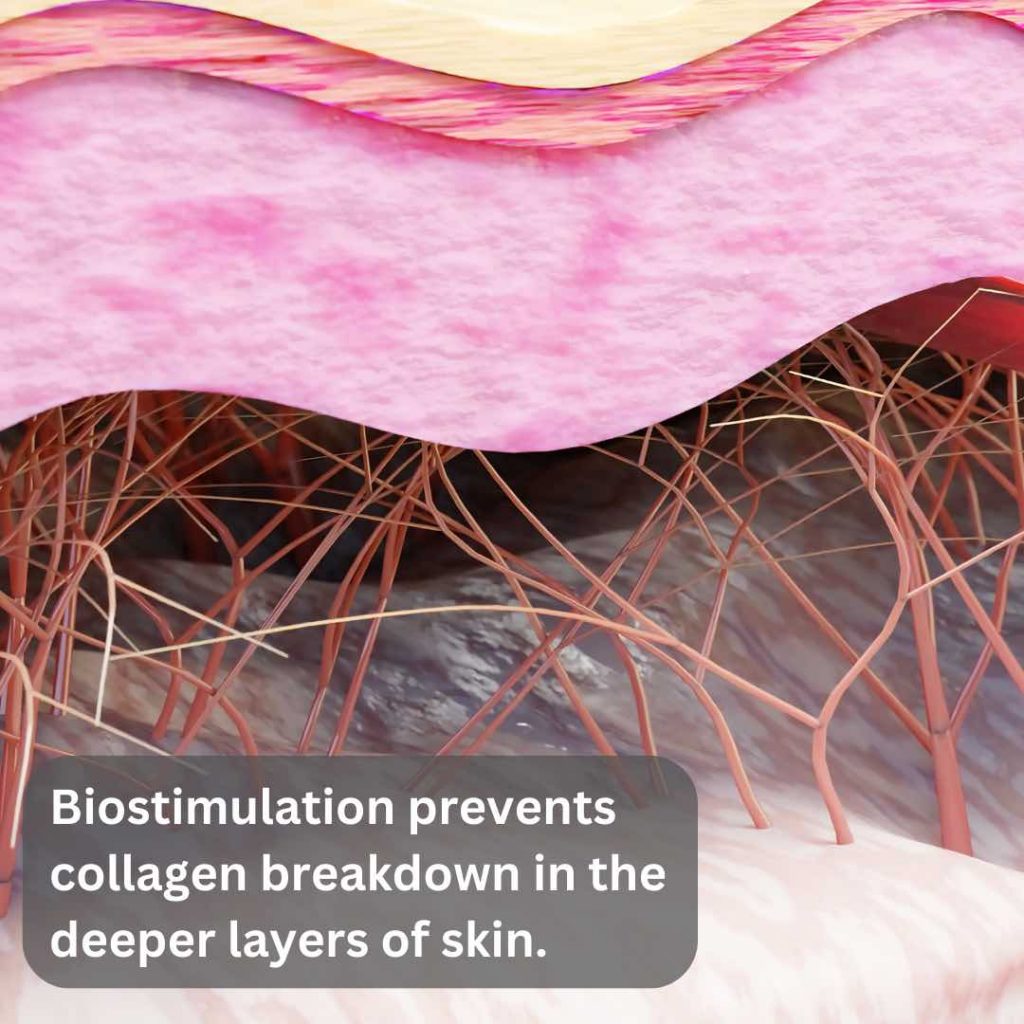
This is the term which combines the use of injectables with high level biostimulation. The initial phase of collagen stimulation is chosen based upon the clinical findings of the patient. Treatments can be CO2 resurfacing, fractional lasers, Hybrid lasers, chemical peels, RF microneedling (moderate level biostimulation), HIFU or combination treatments.
Once phase one is completed, momentum is obtained with injectables. The type & frequency is based on the algorithm discussed above. A simple program combines HA biostimulators & non-HA based, 2 sessions of each post laser resurfacing, followed by one session of each annually.
Home based devices; are they useful?
Marginally at best. This includes LED masks, microneedling devices, RF home devices & microcurrent. These devices are cost effective, safe & can provide extremely low levels of biostimulation. They have a place in maintaining self care with a warm & fuzzy placebo effect. IMO if you are on a budget, you are better off investing in skin care products or an injectable biostimulator annually.

The importance of skin care
Skin care is important for maintaining the results from laser resurfacing & biostimulatory injectables. A simple, yet effective routine is as follows-
- Antioxidants: vitamin C, E, ferulic acids
- SPF
- Retinol or a retinoid at night
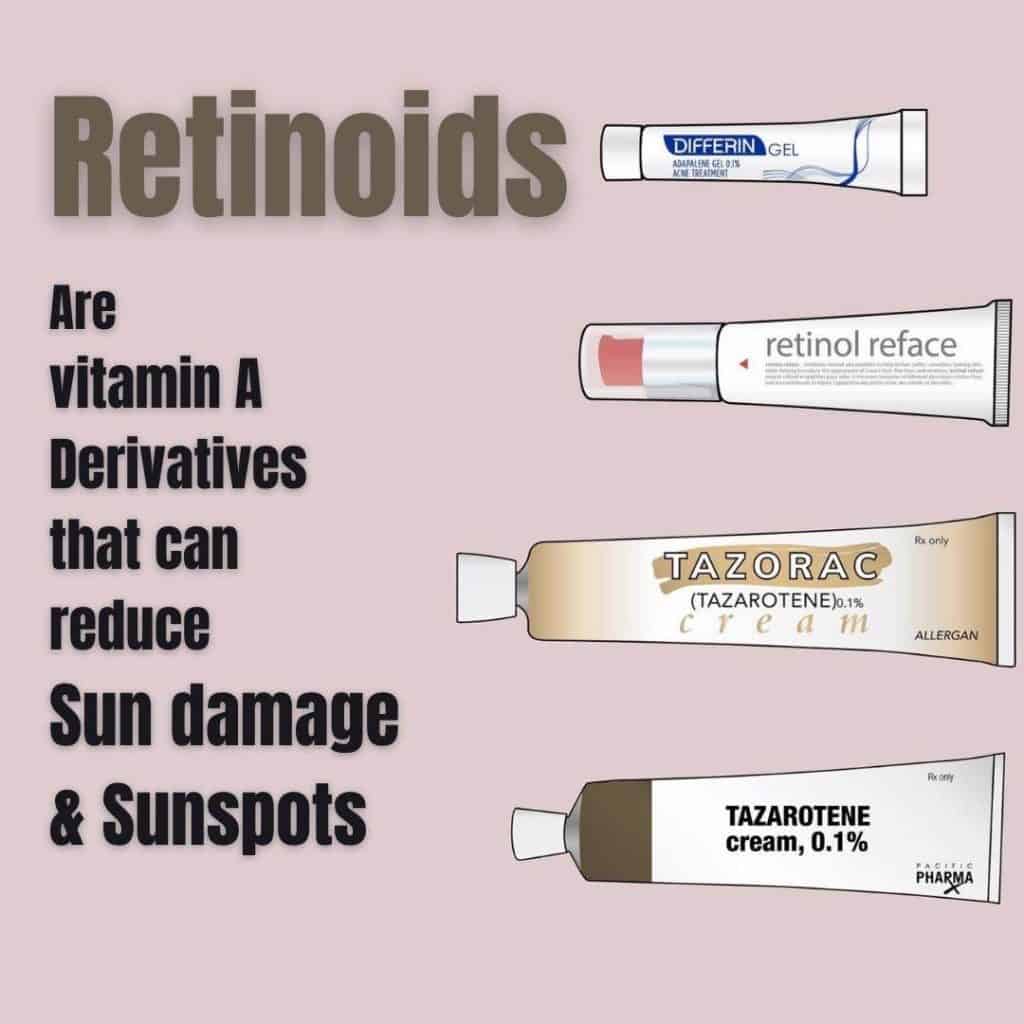
It’s for life
We all want a permanent solution, however time does it stand still. CO2 laser resurfacing will turn back time by over two decades in some, however from there you will still age. Maintaining a healthy lifestyle with regular biostimulation & skin care (to protect rather than correct), can ensure you can maintain your results for as long as possible.
